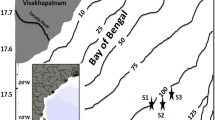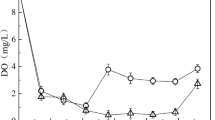Abstract
Studies of nitrogen mineralization and diagenetic status of organic matter evaluated by total hydrolysable amino acids (THAAs) were designed to test the hypothesis that nitrogen mineralization in sediments was a potential source of ammonium in strongly artificially disturbed rivers such as the Ziya River watershed. Ammonium and organic nitrogen in both water and sediment samples were the major forms of nitrogen in the watershed. NH3-N was significantly correlated with organic nitrogen in both water (R = 0.823, P < 0.01) and sediments (R = 0.787, P < 0.01). Organic nitrogen with an average content of 3,275.21 ± 1,476.10 mg · kg−1, accounted for 82.73 % of total nitrogen (TN) in sediments. Organic nitrogen was a potential source of ammonia release into overlying water. Nitrogen mineralization experiments showed that accumulated dissolved inorganic nitrogen ranged from 326.15 to 545.72 mg · kg−1 and accumulated NH3-N ranged from 320.95 to 533.93 mg · kg−1. Most of the mineralized nitrogen was NH3-N ( approximately 98.17 %) and mineralized nitrogen in sediments ranged from 6.20 to 22.10 % of TN. Twenty amino acids were detected, accounting for 45.70 % of organic nitrogen. Protein amino acids, accounting for 89.22 % of THAAs, were the dominant THAAs in sediments. The ratio of L-glutamic acid to γ-aminobutyric acid and degradation index showed that the organic matter was poorly degraded and presented a high potential risk of ammonium mineralization.






Similar content being viewed by others
References
Andersson E, Simoneit BRT, Holm NG (2000) Amino acid abundances and stereochemistry in hydrothermally altered sediments from the Juan de Fuca Ridge, northeastern Pacific Ocean. Appl Geochem 15(8):1169–1190
Aufdenkampe AK, Hedges JI, Richey JE, Krusche AV, Llerena CA (2001) Sorptive fractionation of dissolved organic nitrogen and amino acids onto fine sediments within the Amazon Basin. Limnol Oceanogr 46(8):1921–1935
Benbi DK, Richter J (2002) A critical review of some approaches to modelling nitrogen mineralization. Biol Fertil Soils 35(3):168–183
Beuve N, Rispaill N, Laine P, Cliquet JB, Ourry A et al (2004) Putative role of γ-aminobutyric acid (GABA) as a long-distance signal in up-regulation of nitrate uptake in Brassica napus L. Plant Cell Environ 27(8):1035–1046
Bouché N, Lacombe B, Fromm H (2003) GABA signaling: a conserved and ubiquitous mechanism. Trends Cell Biol 13(12):607–610
Camargo JA, Alonso A (2006) Ecological and toxicological effects of inorganic nitrogen pollution in aquatic ecosystems: a global assessment. Environ Int 32(6):831–849
Canfield DE, Glazer AN, Falkowski PG (2010) The evolution and future of Earth’s nitrogen cycle. Science 330(6001):192–196
Cowie GL, Hedges JI (1994) Biochemical indicators of diagenetic alteration in natural organic matter mixtures. Nature 369:304–307
Cowie GL, Hedges JI, Gregory C (1992) Sources and reactivities of amino acids in a coastal marine environment. Limnol Oceanogr 37(4):703–724
Dauwe B, Middelburg JJ (1998) Amino acids and hexosamines as indicators of organic matter degradation state in North Sea sediments. Limnol Oceanogr 43(5):782–798
Dettmer K, Stevens AP, Fagerer SR, Kaspar H, Oefner PJ (2012) Amino acid analysis in physiological samples by GC–MS with propyl chloroformate derivatization and iTRAQ–LC–MS/MS. Amino Acids Anal Methods Mol Biol 828:165–181
Eickenscheidt T, Heinichen J, Augustin J, Freibauer A, Drösler M (2014) Nitrogen mineralization and gaseous nitrogen losses from waterlogged and drained organic soils in a black alder (Alnus glutinosa (L.) Gaertn.) forest. Biogeosciences 11:2961–2976
Fait A, Fromm H, Walter D, Galili G, Fernie AR (2008) Highway or byway: the metabolic role of the GABA shunt in plants. Trends Plant Biol 13(1):14–19
Fernandes L, Garg A, Borole DV (2014) Amino acid biogeochemistry and bacterial contribution to sediment organic matter along the western margin of the Bay of Bengal. Deep-Sea Res I Oceanogr Res Pap 83:81–92
Gao HF, Bai JH, Xiao R, Yan DH, Huang LB et al (2012) Soil net nitrogen mineralization in salt marshes with different flooding periods in the Yellow River Delta, China. Clean Soil Air Water 40(10):1111–1117
Gao HF, Bai JH, He XH, Zhao QQ, Lu QQ et al (2014) High temperature and salinity enhance soil nitrogen mineralization in a tidal freshwater marsh. PLoS ONE 9(4):e95011
Grutters M, Raaphorst WV, Helder W (2001) Total hydrolysable amino acid mineralisation in sediments across the northeastern Atlantic continental slope (Goban Spur). Deep-Sea Res I Oceanogr Res Pap 48(3):811–832
Hansen LS, Blackburn TH (1991) Aerobic and anaerobic mineralization of organic material in marine sediment microcosms. Mar Ecol Prog Ser 75(2):283–291
Joye SB, Hollibaugh JT (1995) Influence of sulfide inhibition of nitrification on nitrogen regeneration in sediments. Science 270(5236):623–625
Kaiser K, Benner R (2005) Hydrolysis-induced racemization of amino acids. Limnol Oceanogr Methods 3:318–325
Kalvelage T, Lavik G, Lam P, Contreras S, Arteaga L et al (2013) Nitrogen cycling driven by organic matter export in the South Pacific oxygen minimum zone. Nat Geosci 6(3):228–234
Kemp WM, Sampou P, Caffrey J, Mayer M, Henriksen K et al (1990) Ammonium recycling versus denitrification in Chesapeake Bay sediments. Limnol Oceanogr 35(7):1545–1563
Kristensen E, Andersen F, Holmboe N, Holmer M, Thongtham N (2000) Carbon and nitrogen mineralization in sediments of the Bangrong mangrove area, Phuket, Thailand. Aquat Microb Ecol 22(2):199–213
Li Y, Wang X, Yang F (2003) Studies on the function and application of non-protein amino acids. J Shanghai Inst Tech 3(3):194–198
Li SS, Shan BQ, Zhang H (2013) Characteristics and ecological risk assessment of heavy metal pollution in surface sediments of Fuyang River. Acta Sci Circumst 33(8):2277–2284
Li XF, Hou LJ, Liu M, Lin XB, Li Y et al (2014) Primary effects of extracellular enzyme activity and microbial community on carbon and nitrogen mineralization in estuarine and tidal wetlands. Appl Microbiol Biotechnol 99(6):2895–2909
Liu XB, Li GF, Liu ZG, Guo WH, Gao NY (2010) Water pollution characteristics and assessment of lower reaches in Haihe River Basin. Procedia Environ Sci 2:199–206
Lomstein BA, Jorgensen BB, Schubert CJ, Niggemann J (2006) Amino acid biogeo-and stereochemistry in coastal Chilean sediments. Geochim Cosmochim Acta 70(12):2970–2989
Ludwig R, Pringault O, De Wit R, De Beer D, Jonkers HM (2006) Limitation of oxygenic photosynthesis and oxygen consumption by phosphate and organic nitrogen in a hypersaline microbial mat: a microsensor study. FEMS Microbiol Ecol 57(1):9–17
Ma LH, Duan Y, Song ZG (1999) Compositions and contents of amino acids in core sediments from Chinese Nanshan Sea area and paleoenvironment. Acta Sedimentol Sin 17(S1):794–797
Ming TY, Li JJ, Huo P, Wei YL, Chen XH (2014) Analysis of free amino acids in Russula griseocarnosa harvested at different stages of maturity using iTRAQ®-LC-MS/MS. Food Anal Methods 7(9):1816–1823
Ni SQ, Ni JY, Hu DL, Sung S (2012) Effect of organic matter on the performance of granular anammox process. Bioresour Technol 110:701–705
Olk D (2007) Organic forms of nitrogen. Soil sampling and method of analysis. In: Carter MR, Gregorich EG (eds) 667–674
Pathak H, Rao DLN (1998) Carbon and nitrogen mineralization from added organic matter in saline and alkali soils. Soil Biol Biochem 30(6):695–702
Roberts KL, Eate VM, Eyre BD, Holland DP, Cook PLM (2012) Hypoxic events stimulate nitrogen recycling in a shallow salt-wedge estuary: the Yarra River estuary, Australia. Limnol Oceanogr 57(5):1427–1442
Schulten HR, Schnitzer M (1998) The chemistry of soil organic nitrogen: a review. Biol Fertil Soils 26(1):1–15
Schütta M, Borkena W, Spottb O, Stangec CF, Matzner E (2014) Temperature sensitivity of C and N mineralization in temperate forest soils at low temperatures. Soil Biol Biochem 69:320–327
Song JM, Ma HB, Lu XX, Yuan HM (2003) Biogeochemicalfunctions of nitrogen in Bohai Sea sediments. Stud Mar Sin 45:86–100
Stanford G, Smith SJ (1972) Nitrogen mineralization potentials of soils. Soil Sci Soc Am J 36(3):465–472
Stanford G, Frere MH, Schwaninger DH (1973) Temperature coefficient of soil nitrogen mineralization. Soil Sci 115(4):321–323
Tang WZ, Cui JG, Shan BQ, Wang C, Zhang WQ (2014) Heavy metal umulation by periphyton is related to eutrophication in the Hai River Basin, Northern China. PLoS ONE 9(1)
Tenore KR (1983) Organic nitrogen and caloric content of detritus III. Effect on growth of a deposit-feeding polychaete, Capitella capitata. Estuar Coast Shelf Sci 17(6):733–742
Tripathi BN, Gaur JP (2004) Relationship between copper-and zinc-induced oxidative stress and proline accumulation in Scenedesmus sp. Planta 219(3):397–404
Van Cleve K, Yarie J, Erickson R, Dymess CT (1993) Nitrogen mineralization and nitrification in successional ecosystems on the Tanana River floodplain, interior Alaska. Can J For Res 23(5):970–978
Vandewiele S, Cowie G, Soetaert K, Middelburg JJ (2009) Amino acid biogeochemistry and organic matter degradation state across the Pakistan margin oxygen minimum zone. Deep-Sea Res II Top Stud Oceanogr 56(6–7):376–392
Wang C, Shan BQ, Zhang H, Zhao Y (2014) Limitation of spatial distribution of ammonia-oxidizing microorganisms in the Haihe River, China, by heavy metals. J Environ Sci (China) 26(3):502–511
Zhang J, Zhang R, Wu Q, Xu N (2012) Diagenetic alterations of amino acids and organic matter in the upper Pearl River Estuary surface sediments. Biogeosciences 9(1):555–564
Zhang R, Zeng FX, Liu WJ, Zeng RJ, Jiang H (2014a) Precise and economical dredging model of sediments and its field application: case study of a river heavily polluted by organic matter, nitrogen, and phosphorus. Environ Manag 53(6):1119–1131
Zhang YL, Kaiser K, Li L, Zhang DN, Ran Y et al (2014b) Sources, distributions, and early diagenesis of sedimentary organic matter in the Pearl River region of the South China Sea. Mar Chem 158:39–48
Zhao DY, Han LS, He ZJ, Zhang J, Zhang YJ (2014) Identification of the plasma metabolomics as early diagnostic markers between biliary atresia and neonatal hepatitis syndrome. PLoS ONE 9(1):e85694
Acknowledgments
This work was supported by the National Natural Science Foundation of China (No. 21107126) and the National Water Pollution Control and Management Technology Major Projects of China (No. 2012ZX07203-006 and No. 2012ZX07203-003).
Ethical statement
I certify that this manuscript is original and has not been published and will not be submitted elsewhere for publication. The study is not split up into several parts to increase the quantity of submissions and submitted to various journals or to one journal over time. No data have been fabricated or manipulated (including images) to support your conclusions. No data, text, or theories by others are presented as if they were our own.
The submission has been received explicitly from all co-authors. And authors whose names appear on the submission have contributed sufficiently to the scientific work and therefore share collective responsibility and accountability for the results.
No specific permissions were required for these locations, because the study area is not privately-owned or protected in any way. The field studies did not involve endangered or protected species.
The authors declare that they have no conflict of interest.This article does not contain any studies with human participants or animals performed by any of the authors. Informed consent was obtained from all individual participants included in the study.
Author information
Authors and Affiliations
Corresponding author
Additional information
Responsible editor: Zhihong Xu
Rights and permissions
About this article
Cite this article
Zhao, Y., Shan, B., Tang, W. et al. Nitrogen mineralization and geochemical characteristics of amino acids in surface sediments of a typical polluted area in the Haihe River Basin, China. Environ Sci Pollut Res 22, 17975–17986 (2015). https://doi.org/10.1007/s11356-015-4873-0
Received:
Accepted:
Published:
Issue Date:
DOI: https://doi.org/10.1007/s11356-015-4873-0




